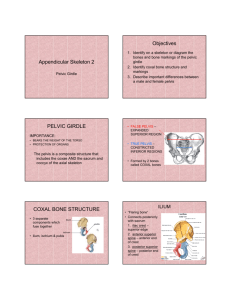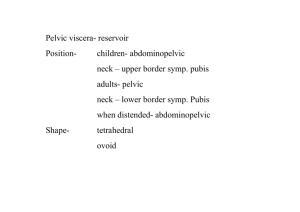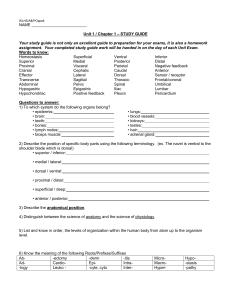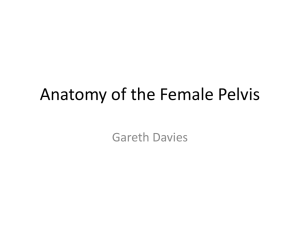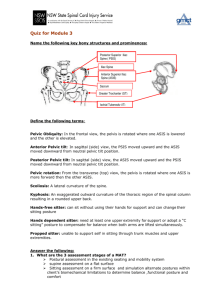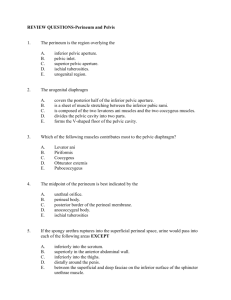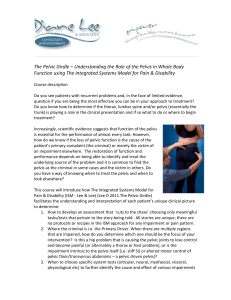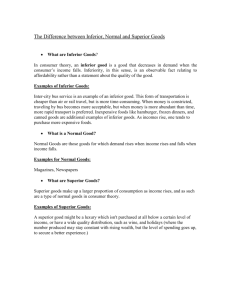The Pelvis and Perineum
advertisement
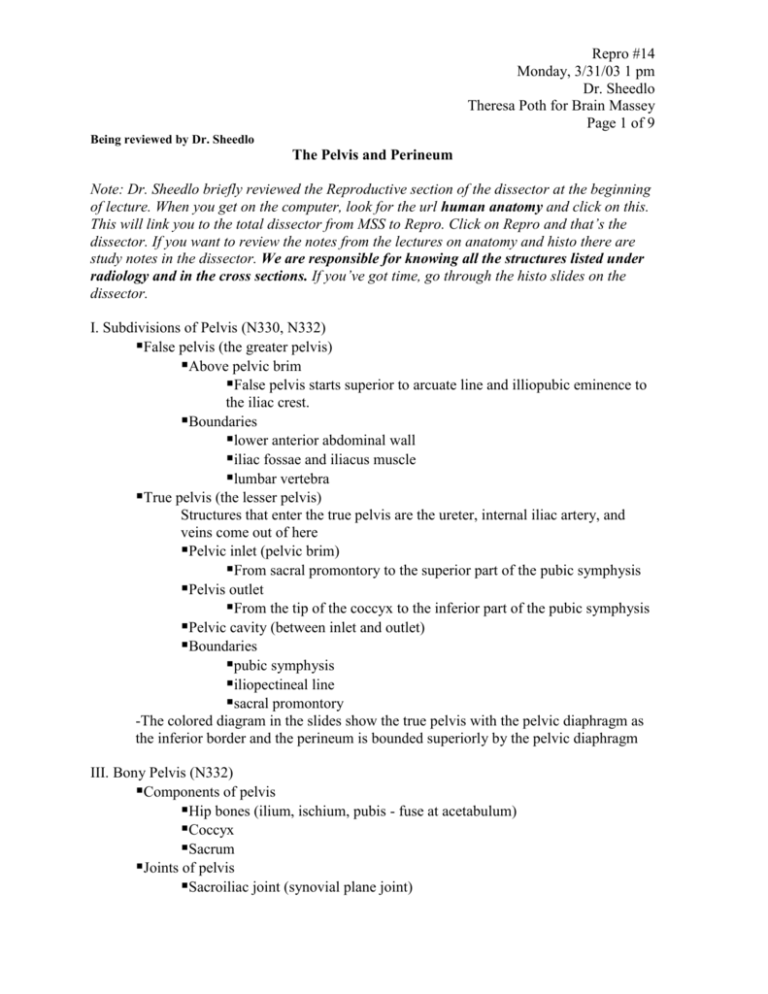
Repro #14 Monday, 3/31/03 1 pm Dr. Sheedlo Theresa Poth for Brain Massey Page 1 of 9 Being reviewed by Dr. Sheedlo The Pelvis and Perineum Note: Dr. Sheedlo briefly reviewed the Reproductive section of the dissector at the beginning of lecture. When you get on the computer, look for the url human anatomy and click on this. This will link you to the total dissector from MSS to Repro. Click on Repro and that’s the dissector. If you want to review the notes from the lectures on anatomy and histo there are study notes in the dissector. We are responsible for knowing all the structures listed under radiology and in the cross sections. If you’ve got time, go through the histo slides on the dissector. I. Subdivisions of Pelvis (N330, N332) False pelvis (the greater pelvis) Above pelvic brim False pelvis starts superior to arcuate line and illiopubic eminence to the iliac crest. Boundaries lower anterior abdominal wall iliac fossae and iliacus muscle lumbar vertebra True pelvis (the lesser pelvis) Structures that enter the true pelvis are the ureter, internal iliac artery, and veins come out of here Pelvic inlet (pelvic brim) From sacral promontory to the superior part of the pubic symphysis Pelvis outlet From the tip of the coccyx to the inferior part of the pubic symphysis Pelvic cavity (between inlet and outlet) Boundaries pubic symphysis iliopectineal line sacral promontory -The colored diagram in the slides show the true pelvis with the pelvic diaphragm as the inferior border and the perineum is bounded superiorly by the pelvic diaphragm III. Bony Pelvis (N332) Components of pelvis Hip bones (ilium, ischium, pubis - fuse at acetabulum) Coccyx Sacrum Joints of pelvis Sacroiliac joint (synovial plane joint) Repro # 14 3/31/03 1 pm Page 2 of 9 Pubic symphysis (fibrocartilage) Sacrococcygeal joint (flexible) Important in childbirth Obturator membrane (N330) This is important for orientation in the pelvis Almost completely closes the obturator foramen A gap, obturator canal, allows the obturator artery and nerve to exit the pelvis to enter the thigh and the obturator vein to enter the pelvis from the thigh Ligaments of pelvis (N331) Iliolumbar ligament (L5 to iliac crest) Sacrotuberous ligament Sacrospinous ligament Coccygeus m. rest on this ligament….if you cut through this muscle you will see this ligament Sacroiliac ligaments Anterior sacroiliac ligament Posterior sacroiliac ligament Interosseous sacroiliac ligament (M216) The strongest of the three that hold the sacroiliac joint together IV. Differences in the Male and Female Pelvis (N332) Depth - female is shallower than male Shape of pelvic inlet - oval in female, heart-like in the male Size of pelvic outlet - larger in female-due to childbirth Size of pelvic cavity - roomer and distance from inlet to outlet is shorter in female Ischial tuberosities - everted in female, inverted in male Sacrum - shorter, wider and flatter in female Pubic arch - rounder and wider in female V. Muscles of Pelvis (N333) -The first two help to create the wall of muscle in the pelvis Piriformis m.-important in the gluteal region because was a landmark for superior and inferior regions, important in the pelvis because of the sacral nerves found at the base of the pelvic cavity Sacrum through greater sciatic foramen to greater trochanter of femur Nerve: anterior rami of S1 and S2 Action: lateral rotator of hip joint Obturator internus m. Obturator membrane and adjacent bone through lesser sciatic foramen to greater trochanter of femur Nerve: anterior rami of L5 and S1 Repro # 14 3/31/03 1 pm Page 3 of 9 Action: lateral rotator of hip joint Pelvic diaphragm Consists of muscles and their fasciae Supports the pelvic viscera Coccygeus m. (ischio-) Ischial spine to sacrum and coccyx If you cut this muscle, what do you see? Sacrospinous ligament Nerve: anterior rami of S4 and S5 Levator ani mm. (tendinous arch) We will not have to differentiate the below mm. in our dissection but are responsible for the cross sections. Iliococcygeus m. - tendinous arch to raphe between anal canal and coccyx (more lateral) Pubococcygeus m. - pubis to vagina/prostate, anorectal junction to perineal body Perineal body is important because it can be damaged during childbirth Puborectalis m. - part of external anal sphincter from pubis to junction of anus and rectum Most medial-forms a “sling” at the anal-rectal junction, it’s keeping everything up Nerve supply - anterior rami of S3 and S4 Review: Posterior to Anterior -Piriformis → Obturator internus→ Coccygeus→iliococcygeus→pubococcygeus→puborectalis VI. Nerves of Pelvis (N381) Sacral plexus (to pelvic mm., viscera and perineum) Posterior pelvic wall on anterior surface of piriformis m. Anterior rami of L4-L5 and S1-S4 L4-L5 form lumbosacral trunk Pudendal n. (S2-S4) leaves via greater sciatic foramen within Alcock’s canal, inferior to piriformis and passes into the lesser sciatic foramen -Alcock’s canal is important for a pudendal nerve block. Inferior rectal n. Dorsal n. of penis or clitoris Perineal n. Nerves to piriformis m. Perforating cutaneous n. Sacral plexus leaves the pelvis through greater sciatic foramen (N468) Sciatic n. (L4-5, S1-3) Superior gluteal n. (L4-5, S1) Inferior gluteal n. (L5, S1-2) Repro # 14 3/31/03 1 pm Page 4 of 9 Nerve to obturator internus m. (L5, S1-2) Nerve to quadratus femoris m. (L5, S1) Posterior cutaneous n. of thigh (S1-3) VII. Arteries of Pelvis (N373) ****Dr. Sheedlo is giving us the normal orientation of these vessels, be mindful that you will find variations of these orientations depending on what textbook you read. For example, in Gray’s Anatomy he will write that 30% to 40% of the time a vessel will take this origin, etc. Common iliac a.(from aorta, branches at L4) Internal iliac a. (anterior division) Obturator a. - obturator canal Nerve will be present with vein and artery Several times last year, artery came off inferior epigastric and you’ll find just the nerve Umbilical a. - superior vesical aa. to top of bladder Umbilical a becomes occluded and continues as the medial ligament Uterine a. - crosses ureter anteriorly Vaginal a. - vagina and base of bladder Inferior vesical a. - base of bladder Middle rectal a.-may or may not originate from internal iliac, may have common branch with inferior vesical a. Internal pudendal a. - greater sciatic foramen with pudendal n. on the obturator internus m., called Alcock’s canal Inferior gluteal a. - below piriformis m. Provides blood to the gluteus maximus Internal iliac a. (posterior division) Iliolumbar a. - passes superiorly across pelvic inlet Lateral sacral a. - anterior to sacral plexus Superior gluteal a. - greater sciatic foramen superior to piriformis m. exits pelvis between the lumbosacral trunk, where L4/L5 merge with S1 and form a V Common iliac a. (N247) External iliac a. Inferior epigastric a. Deep circumflex iliac a. The external iliac a. continues as femoral a. as it passes beneath inguinal ligament Superior rectal a. Inferior mesenteric a. Middle (median) sacral a. Bifurcation of abdominal aorta (L4) Ovarian or testicular a. Repro # 14 3/31/03 1 pm Page 5 of 9 Abdominal aorta VIII. Veins of Pelvis (N248) External iliac v. Continuation of femoral v. Internal iliac v. Joins with external iliac v. to form common iliac v. which merge to form the inferior vena cava (at L5) Middle (median) sacral v. Drains into the left common iliac v. IX. Lymphatics of Pelvis (N249) Lymphatic drainage from the pelvis is primarily to external and internal iliac nodes common iliac nodes X. Perineum (N352) The perineum is a diamond-shaped region The boundaries of the perineum pubic symphysis - anteriorly ischiopubic rami - anterolaterally ischial tuberosity - laterally sacrotuberous ligament - posterolateral coccyx - posteriorly A line connecting the ischial tuberosities divides the perineum into the urogenital triangle (anterior) anal triangle (posterior) XI. Urogenital Diaphragm (N357) The urogenital diaphragm is a triangular muscle in the anterior part of the perineum in the pubic arch It is formed by the sphincter urethrae m. and deep transverse perineal m. It is covered by the superior and inferior fascia (perineal membrane) XII. Urogenital Triangle Superficial perineal space (N351,N352) Between the urogenital diaphragm and superficial perineal (Colles’) fascia The contents of this space include ischiocavernosus mm. bulbospongiosus mm. superficial transverse perineal m. perineal body greater vestibular (Bartholin’s) glands in female Deep perineal space (N357) Lies between superior and inferior fasciae of the urogenital diaphragm The contents of this space deep transverse perineal m. Repro # 14 3/31/03 1 pm Page 6 of 9 sphincter urethrae m. urogenital diaphragm bulbourethral glands in male secrete into the bulbous portion of the urethra XIII. Anal Triangle (N364) –posterior portion of perineum The anal triangle contains the two ischiorectal (anal) fossae The ischiorectal fossae lie on either side of the midline of the perineum This fossae lies between the levator ani and the obturator internus mm. The pudendal canal (Alcock’s) contains the internal pudendal vessels and pudendal n. Landmarks for a pudendal nerve block is the ischial tuberosity, because an inch superior to that is the pudendal nerve Boundaries (N368) Superficial and deep transverse perineal mm. - anterior Gluteus maximus m. and sacrotuberous ligament - posterior Levator ani m. and external anal sphincter m. - superomedial Obturator internus m. - lateral XIV. Urinary Bladder (N342, N343) Functions to store urine (500ml) Located behind pubic bones in pelvis When fully distended, it can reach umbilicus Segments apex - anterior superior surface - peritoneum fundus and body - posteroinferior neck - leads to urethra/inferolateral uvula - projects into urethral orifice at the the apex of the trigone Interior features Trigone - bounded by internal urethral orifice and orifices of two ureters Interureteric ridge - between two orifices of ureters Detrusor muscle - smooth muscle Sphincter vesicae - internal urethral sphincter (smooth muscle) Uvula vesicae - prostate median lobe ▪Blood supply (N374,N321) Superior and inferior vesical aa. Vein from the vesical venous plexus drain into internal iliac v. Lympathic drainage Internal and external iliac nodes Nerves (N322) The nerves that supply the bladder are continuous with the inferior hypogastric plexus The sympathetic fibers (T11 - L2) inhibit contraction of detrusor muscle The parasympathetic fibers (pelvic splanchnic nn.) stimulate contraction of detrusor muscle and inhibit action of sphincter vesicae Repro # 14 3/31/03 1 pm Page 7 of 9 XV. Male Urethra (N359) Description Extends from urinary bladder to external urethral orifice The male urethra is ~8” in length Prostatic urethra Widest and most dilatable segment Urethral crest (seminal colliculus) Prostatic sinus - openings of prostate gland Prostatic utricle - vagina/uterus of female Ejaculatory ducts open in the edge of mouth of utricle Membranous urethra - sphincter urethrae m. Spongy urethra Consists of a bulbous and penile segments Bulbourethal ducts open Urethral glands open XVI. Female Urethra (N353) Description Extends from urinary bladder to external urethral orifice The female urethra is ~1.5” in length The ducts of Skene gland (mucus) open into urethra XVII. Rectum (N365) Description The rectum is ~5” in length It begins at S3 and extends to tip of coccyx Puborectalis m. forms sling at rectoanal junction Transverse folds of rectum in rectal walls Left wall - superior and inferior Right wall – middle Also called valves of Houston XVIII. Arteries of Rectum (N369) Arteries Superior rectal a. Continuation of inferior mesenteric a. Divides and anastomoses with middle and inferior rectal aa. Middle rectal a. Branch of internal iliac a. Inferior rectal a. Branch of internal pudendal a. XIX. Veins of Rectum (N370) Veins Superior rectal v. Drains into inferior mesenteric v. Inferior then drains to Splenic v which then merges with the superior mesenteric v to form the Portal v. Middle rectal v. Repro # 14 3/31/03 1 pm Page 8 of 9 Drains into internal iliac v. Inferior rectal v. Drains into internal pudendal v. **This drainage is unique because there are both drainage to the portal v and IVC*** XX. Rectum (N297, N379) Lymphatics Inferior mesenteric nodes (superior and middle third) Internal iliac nodes (lower third) The rectum is only sensitive to stretch Nerves(N381) Nerve supply is from parasympathetic and sympathetic systems Sympathetic - superior hypogastric plexus Parasympathetic - inferior hypogastric plexus XXI. Anal Canal (N365) ***This region is important, expect anatomical questions differentiating between regions in the anal canal*** Description The anal canal is ~1.5” in length It lies below pelvic diaphragm to anus ▪Upper half (N365,N366) Lined by columnar epithelium (goblet cells) Anal columns (Morgagni) - 5-10 folds Anal valve - at lower ends of columns Superior rectal a. and v. Autonomic hypogastric plexus - sensitive to only stretch Pectinate line Separates the visceral portion (inferior hypogastric plexus) and somatic portion (inferior rectal n.) Lower half Lined by stratified squamous epithelium No anal columns Inferior rectal a. Inferior rectal n. - thus sensitive to pain, temperature and pressure Inferior rectal v. Anal sphincters (N366) Internal anal sphincter Involuntary control Thickened inner circular smooth muscle at superior anal canal External anal sphincter Voluntary control Skeletal muscle Three parts Subcutaneous - lower end of anal canal Superficial - attached to coccyx and perineal body Deep - blends with puborectalis m. Repro # 14 3/31/03 1 pm Page 9 of 9 XXII. Hemorrhoids (N370) Internal hemorrhoids are prolapses of internal rectal venous plexus - beneath mucous membrane External hemorrhoids are usually thromboses in veins of external rectal venous plexus - sides of external sphincter The superior, middle and inferior rectal veins anastomose and form a portal and systemic venous communication A pressure increase in the portal system may cause enlargement of superior rectal veins leading to internal hemorrhoids

